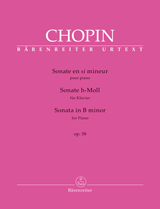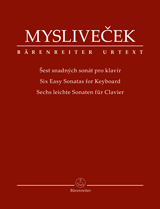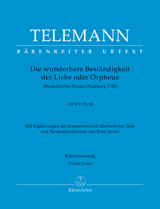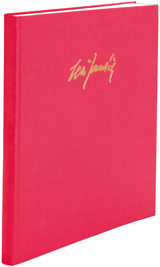 | Urtext edition reflecting the latest Chopin research
With valuable notes on interpretation and performance practice (Ger/Fr/Eng)
Includes Chopin’s original fingering supplemented by Hardy Rittner |
|
| Chopin, Frédéric | | Sonata for Piano in B minor op. 58 | BÄRENREITER URTEXT
Editors: Badura-Skoda, Paul / Schilling-Wang, Britta | | BA 11828 | EUR 15.95 | Performance score | 9790006565061 | The Sonata in B minor op. 58 (1844) is Chopin's third and most important contribution to this genre. This Urtext edition reflects the latest musicological research and is based on the version of the French first edition, in which Chopin made changes right up to the printing stage and beyond. The countless variants compared to the musical text of the German version, which is still mainly performed today, concern not only articulation and dynamics but above all significant changes to the notes themselves.
A Foreword (Ger/Fr/Eng) provides information on the genesis, the complicated source filiation as well as Chopin’s understanding of the work. Notes on interpretation and performance practice (including tempo, ornamentation, use of pedal, rubato and hidden inner melodic lines) based on a wealth of experience by Paul Badura-Skoda, a pioneer of historically-informed playing, and Hardy Rittner, Professor of Piano at the Musikhochschule Freiburg and author of a current fundamental work on Chopin's piano playing published by Bärenreiter (BVK04005), support the study of this work. Moreover, the reader-friendly engraved musical text contains Chopin’s deviating pedal markings from the autograph engraver's copy for the German first edition in small print. Chopin’s original fingering has been meticulously supplemented by Hardy Rittner. The detailed Critical Commentary (Eng) reflects the great divergence between the sources. It documents readings that are particularly important for interpretation and illuminates editorial decisions (a detailed version of the Critical Commentary is available digitally). | | |
|
 | First Urtext edition of six well-known sonatas by Mysliveček for keyboard
An ideal introduction to the classical period
Detailed commentary by the editor on performance practice during the 2nd half of the 18th century |
|
| Myslivecek, Josef | | Six Easy Sonatas for Keyboard | BÄRENREITER URTEXT
Editor: Spurný, Vojtech | | BA 11568 | EUR 18.95 | Performance score | 9790260109698 | Numerous copies of the sonatas for piano/harpsichord by Josef Mysliveček (1737-1781) are scattered throughout Europe, which testifies to their popularity at the time (among others, W. A. Mozart mentioned them approvingly in a letter to his father). Three years after the composer's death, they were published in Edinburgh under the title “Six Easy Lessons for the Harpsichord”.
Until now, there has been no edition that has taken all available sources into account. Vojtech Spurný, the editor of this Urtext edition who is a pianist, conductor and specialist in historical performance practice, relied on a copy of the sonatas from the Bavarian State Library in Munich as his main source.
The sonatas are suitable both as concert literature and for teaching purposes, as they represent an ideal introduction to the classical period.
|
|
 | With additions by René Jacobs
Informative bilingual Foreword (Ger/Eng)
Practical, easy-to-play piano reduction |
|
| Telemann, Georg Philipp | Die wunderbare Beständigkeit der Liebe oder Orpheus TVWV 21:18
Musical Drama
Hamburg 1726 | BÄRENREITER URTEXT
Editors: Hirschmann, Wolfgang / Grapenthin, Ulf | | BA 11736-90 | EUR 42.95 | Vocal Score (It/Fr/Ger) | 9790006575923 | In Georg Philipp Telemann's opera "Orpheus", the focus is not on Eurydice, but on Queen Orasia, who is inflamed with mad but unrequited love for the legendary singer.
The first documented performance of the work took place in Hamburg in 1726. In keeping with the appealing multilingualism of the libretto (German, Italian and French), the composer presents the recitatives, arias and choruses in the various national musical styles and, depending on the dramatic and scenic occasion, ranging from the songlike to the pathetic and virtuosic.
The vocal score, which is based on the Urtext of the "Telemann Musical Works", also includes editorially marked additions (including new compositions of recitatives that have only been handed down in text form) by René Jacobs, a specialist in this repertoire. | | |
|
Notes
The Musician's Choice
Bärenreiter notebook with a cover in Ravel lime green | |
| BA 8100-46 | EUR 0.95 | 9790006579273 |
|
Notes
The Musician's Choice
Bärenreiter notebook with a cover in Brahms olive green | |
| BA 8100-48 | EUR 0.95 | 9790006579280 | These little notebooks are handsome as well as practical. The covers are in Bärenreiter’s attractive Ravel lime-green (BA 8100-46) and Brahms olive-green (BA 8100-48) and have the same layout as our Urtext editions. The pages alternate with musical staves on the left and writing lines on the right. The superior quality of paper used for the notebooks matches that of our fine Urtext editions.
"Bärenreiter Notes" serves ideally as:
- A student lesson book
- A general notebook
- A gift | | |
|
| Schubert, Franz | | Mass in G major | New Schubert Edition I/1b
Editor: Martin, Christine | | BA 5583-01 | EUR 215.00 | Full score, linen-bound | 9790006577729 | | Reduced subscription price available | Franz Schubert's Mass in G major (D 167) was composed in 1815 for his home parish in Vienna-Lichtenthal. It was initially intended as a Missa brevis with string orchestra and organ, but was soon supplemented by two trumpets and timpani ad libitum for more festive occasions. This instrumentation is documented in a set of parts that Schubert himself wrote shortly after his full score was completed. Numerous other copies of parts from Schubert's circle prove that the composer continued to experiment with the form and scoring of the mass during and after the first performances and adapted it to the respective performance conditions. Even today, the Mass in G major is one of his most popular and most frequently performed compositions.
This "New Schubert Edition" volume includes the work in its first version for strings for the first time. Furthermore, it contains the second version with trumpets and timpani which, in addition to the altered scoring, also includes numerous minor changes to the musical text. The appendix offers two variants of individual movements from Viennese part copies, which Schubert most probably would also have tolerated. In the Foreword, Christine Martin places the mass and its various versions in the context of Viennese church music of the early 19th century and comments on references to the historical performance practice of the mass, which emerge from contemporary sources.
In addition to a mixed four-part choir, string orchestra and organ, the scoring includes three solo voices (soprano, tenor and bass) and, in the second version, two trumpets and timpani ad libitum. |
|
 | Five mixed choruses from the years 1877-1890 and six "Hukvaldy Songs" in a choral arrangement (1899)
Vocal texts in three languages (Cz/Eng/Ger)
Trilingual Foreword (Cz/Eng/Ger) and a Critical Commentary (Eng) |
|
| Janácek, Leoš | | Mixed Choruses | Complete Critical Edition of the Works of Leoš Janácek C/4
Editors: Faltus, Leoš / Zahrádka, Jirí | | BA 6870-01 | EUR 130.00 | Full score, linen-bound | 9790260109933 | | Reduced subscription price available | Works for choir are represented in the œuvre of Leoš Janáček (1854-1928) from his beginnings as a composer until almost the last days of his life. Already in his youth he was intensively involved as a choral director in Brno – as successor to Pavel Křížkovský with the Augustinian church choir, later with the choir of the Svatopluk tradesmen's association and with the Beseda Philharmonic Society.
This volume contains five mixed choruses from the years 1877-1890. Some of these are more of an occasional composition due to the specific event for which they were written such as the "Festive Chorus" for the laying of the foundation stone of the teachers' institute, while other pieces, for example "The Wild Duck" for aspiring singers, already show the future master, who unmistakably draws on folk poetry. The six "Hukvaldy Songs", which Janáček selected from his collection of songs for voice and piano "Hukvaldy Folk Poetry in Songs" (1898) and adapted for choir (1899), also belong to the latter group of works.
This publication follows the editorial principles and guidelines laid down for the "Complete Critical Edition of the Works of Leoš Janácek”, Prague 1979. |
|
| Telemann, Georg Philipp | Geistliches Singen und Spielen
Music for the church based on texts by Erdmann Neumeister
New Year to Esto mihi and the Purification of Mary | Georg Philipp Telemann. Musical Works 67
Editor: Hirschmann, Wolfgang | | BA 7819-01 | EUR 435.00 | Full score, linen-bound | 9790006577118 | | Reduced subscription price available | Volume 67 of the Telemann Musical Works contains the cantatas for New Year to Esto mihi and the Purification of Mary based on texts from the annual cycle "Geistliches Singen und Spielen" by Erdmann Neumeister. Following the publication of a first segment from this annual cycle in 2004 (Telemann Musical Works, 39, ed. by Ute Poetzsch-Seban; 1st Advent to Sunday after Christmas), this volume marks the beginning of a unique project in the series: this annual cycle, which was groundbreaking for Protestant church cantatas and exceptional in the work of Telemann and Neumeister, is being edited in its entirety in a total of seven volumes. ...
|
|
| Gade, Niels Wilhelm | | Songs and Ballads | Niels W. Gade. Works V/1
Editor: Moe, Bjarke | | BA 7632 | EUR 295.00 | Full score, linen-bound | 9790006487899 | | Reduced subscription price available |
|
| Gade, Niels Wilhelm | | Songs and Ballads | Niels W. Gade. Works V/2
Editor: Moe, Bjarke | | BA 7639 | EUR 267.00 | Full score, linen-bound | 9790006579358 | | Reduced subscription price available | Throughout his entire career, Gade composed songs and ballads, from his first known composition in 1834 to 1888. Two thirds of the 112 songs were published during his lifetime, and the remaining ones are now available for the first time. Twelve of the songs are Gade's arrangements of his own music or of music by other composers, and the edition also includes discarded songs.
The contents of the two volumes span from short strophic songs to through-composed art songs set to German and Danish poems. Among Gade's preferred authors are for instance Goethe, Uhland and H.C. Andersen. Gade composed the majority of his songs for use in domestic settings, and only a few of them found their way into the concert repertoire of his time. Nevertheless, Gade was widely recognized for his songs during his lifetime, as evidenced by contemporary reviews and by the large number of editions and reprints in his own days. Among his most popular songs are "The Songs of Ogier the Dane", and the collection of duets, "Neun Lieder (im Volkston)", Op. 9. | | |
|
   
Errors excepted; price changes and delivery terms subject to change without notice.
Responsible for content (i.S. des § 10 Abs. 3 MDStV): Ivan Dorenburg
Your contact at Barenreiter: Carolin Jetter · jetter@baerenreiter.com · Fax +49 (0)561 3105310
Bärenreiter-Verlag Karl Voetterle GmbH & Co. KG · Heinrich-Schütz-Allee 35-37 · 34131 Kassel · Germany
Managing Directors: Prof. h. c. Barbara Scheuch-Vötterle, Leonhard Scheuch, Clemens Scheuch
Firma und Registergericht: Kassel HR A 6553 · Komplementärin: Vötterle-Vermögensverwaltungs-GmbH Kassel HR B 3965
Umsatzsteuer-ID-Nr.: DE113096830
Unsubscribe
|
|
 |
|
|
|
|
|
|
|
|